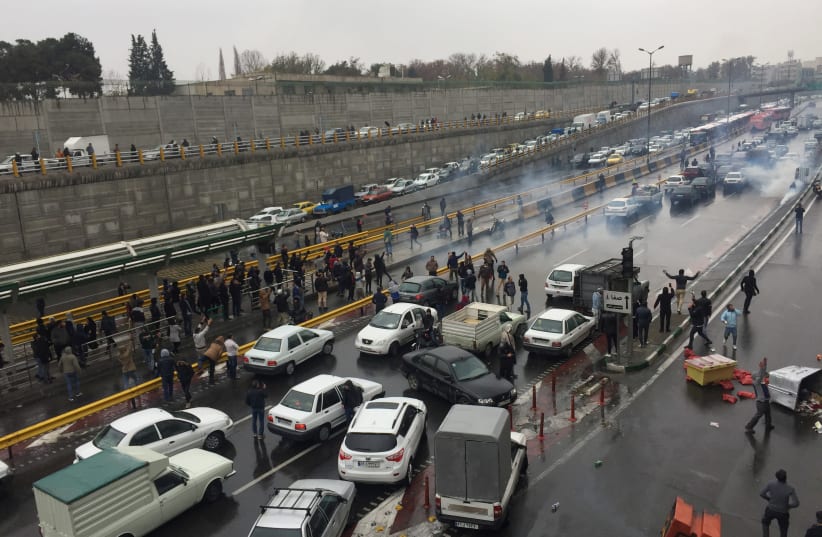#BREAKING: Brave people of Aryashahr in west of #Tehran have blocked the roads on security forces of the #Iran's Islamic regime to make them unable to mobilize their troops to suppress them now.#IranProtests pic.twitter.com/CTQ62eqpxZ
— Babak Taghvaee (@BabakTaghvaee) November 16, 2019
Video recorded in #Tehran this afternoon shows people protesting against #Iran's Islamic Regime over the rising price of goods and fuel. pic.twitter.com/Nh9pK5WTcT
— Babak Taghvaee (@BabakTaghvaee) November 15, 2019
The regime, backed by the Islamic Revolutionary Guard Corps (IRGC) and the Basij militia, with its theocrats calling the shots, began to move against the Internet and then against the protesters in a systematic way. The only way it knows how is to use force, but it must balance that with not wanting to spark a real civil conflict.The problem with Iran’s regime is that while it is authoritarian, it is not a system of total control. Iranians have some freedoms, more than in the most totalitarian states. The regime uses a variety of methods to control people, and brutality is not the only one. It understands the carrot and the stick. It understands that there are many complexities in Iran and that the public is educated. It also knows that its pure propaganda of always blaming the US doesn’t work.After the Internet was shut down, various accounts said that around 100 people were killed in the first 48 hours. By the 100th hour, estimates said more. There were stories of major battles for the streets in some areas as the system sought to regain control. The regime also said this openly. A deputy of the IRGC’s Islamic governing council said that “people will not be allowed to strike the system.” The Basij said that the protests had been crushed in only six hours. Then why was the Internet still out three days later?Abdulrahim Mousavi, commander of Iran’s army, warned against stagnation in the face of “arrogance,” a term that usually means the United States. In a sense this was a warning that the country must be vigilant against the US during this time of internal strife.The closing of the Internet was embarrassing during the meeting of a foundation dealing with technology. At the meeting, an official said the Internet “disruption” would be solved soon, and blamed it on the high-level of messages being sent. In Shiraz, the government organized a pro-regime rally on Thursday to confront the protesters in order to show that “the people” opposed the “riots.”Tehran felt a real challenge by the November 15 protests. It was clear that much of the capital city came to a standstill. Maps where people could indicate road blockages showed must of the city on shutdown. Protests were larger in western Iran, particularly in the partly Arab Ahwaz region, and also in some Kurdish areas. It was also very large in central Iranian cities, less so in the east.#BREAKING: In 2nd day of nationwide protests in #Iran, tens of thousands of #Shiraz's citizens have come to streets of their city to protest against #Iran's Islamic Regime over the increase in fuel price & fund of terrorism abroad by that money.#IranProtests pic.twitter.com/MICB0MF90D
— Babak Taghvaee (@BabakTaghvaee) November 16, 2019
#BREAKING: Protesters have closed & blocked almost all of the highways in #Tehran. #IranProtests against the #Iran's Islamic Regime is going to paralyze the regime & its security forces across the country. pic.twitter.com/eztURREgrQ
— Babak Taghvaee (@BabakTaghvaee) November 16, 2019
Tehran videos from November 17 showed that police had flooded the city. Live fire could be heard on the few videos that were able to make it out of Iran that day. In Shiraz, for instance, gunfire could be heard. Nevertheless at night people continued to confront the regime, with some street clashes caught on video.Symbols of the religious establishment were also attacked, as evidenced by photos from at least one seminary that was burned on November 18. Reports in Tehran said many students at Tehran University took part. Live fire continued to be used on the 18 and 19, including in the Kurdish areas such as Kermashah city. Basij forces enforced curfews in some cities.Whatever the results of the five days of protests, the response by the regime – a total blackout of the Internet – was designed to cut off communication between people so that each protest could be confronted in each city by the security forces.The degree of popular anger is clear. The country has been seething for 10 years. People remember the protests over these years and it is clear that many oppose the regime’s messages about the need to waste resources in Iraq, Syria, Lebanon and among Palestinian groups. The aging Ayatollahs and leadership – many accused recently of corruption – have shown they are incapable of confronting the demands of people. The early chaotic response showed that the protests also have sympathy in some areas of the media and in higher levels of government. The attacks directed at symbols of the regime show that the protesters also do not have fear. Five days of shooting them and trying to crush them might succeed temporarily, but overall, the government faces a long-term struggle against its own people.#IranProtests:an overview of cities across Iran that protests are confirmed to be taking place, according to the pictures and videos that were sent to BBC Persian. pic.twitter.com/7kJ5uCEYgq
— Hadi Nili (@HadiNili) November 16, 2019
